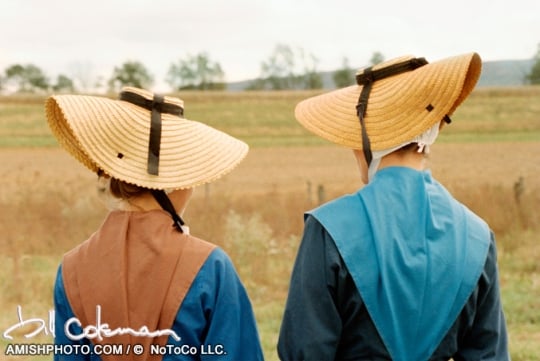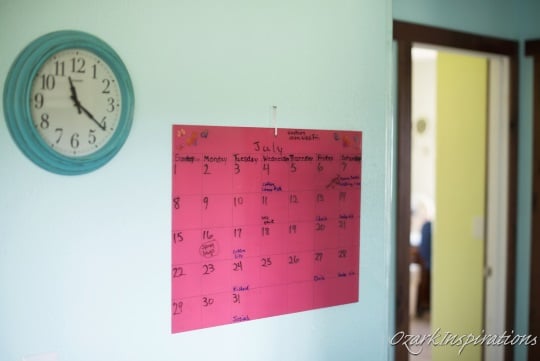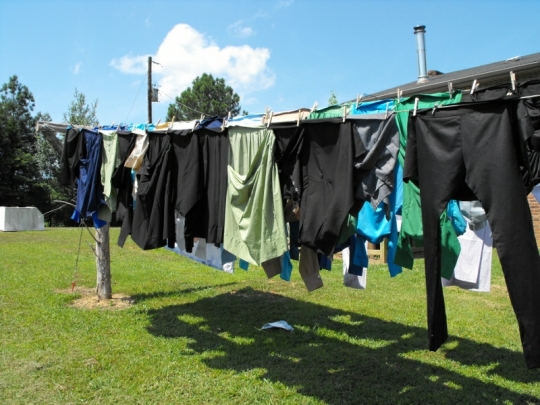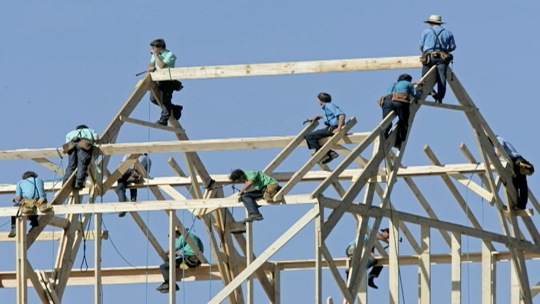What do these Amish women have on their heads?
I got an email yesterday from Bill Coleman’s archivist asking about an unusual photo found in his collection. He described it as “one of Bill’s earliest Amish photographs” and that he had not seen anything similar in any of Bill’s other photos.

This photo “was taken in the early 1980’s…”[women in] scoop hats” is the only thing written on the negative sleeve, which is odd as well since Bill is known for making copious notes on each of the sleeves.”
You can see this is quite different from the various head coverings Amish women typically wear. I’ve never seen these in person but I believe I have an answer to this question which I’ll post here later today. If you have any thoughts or have seen these types of hats before your ideas are welcome.
UPDATE: You readers are great as usual, some very interesting comments came in below (see Terry Berger’s, Naomi Wilson’s, and Barb’s comments, among others). My initial thought on viewing the photo was that these were hats seen among the Nebraska Amish people, primarily of Mifflin County, Pennsylvania. I am not aware of them being worn by any other Amish.
A reader writes in: “I actually own one of these hats. Bought it from a Nebraska Amish woman in Belleville. Figured it was a collectible and very unique. I have seen Nebraska Amish women wearing these while working in the fields. What Amish women wore before the bonnet became fashionable among Amish women.”
In his classic work Amish Society, Amish-raised author and Big Valley native John Hostetler writes about the Nebraska women:
“When working in the fields the women wear the “scoop” or flat hats, made of straw, which resembles the Swiss and Alsatian peasant hats worn two centuries ago. The wide brim is folded down at the sides by means of a string that is tied beneath the chin.”
With a little hunting I found this image (no longer online) which includes a depiction of a similar-looking hat. The subject is described as “a 19th century French country woman from the Alsace region of France wearing her traditional working dress, hat, and carrying a pitchfork.”







hats
Sun protection?
Im houseamish and i think you guys hurt us.Our clothing is not plain.Its actullay really respectfull.And my brother never wears T-shirts or pants.Were not allwoed to.Theres types of maish and all of them are diffenrt
Response
I understand that the clothing is respectable
It hurts us to be called the English
We are not the English. We have names .
And a little wave would be nice also.
Don’t have to put nose up in the air.
I respect you as a person. Your faith interesting. Your life is interesting.
Those actions are very hurtful
I myself have cried. Reason I have tried to talk and I get the stare. Very hurting.
Could it have been windy outside?
SUN HAT
THESE ARE SUN HATS, SILLY LOOKING THINGS IN MY OPINION BUT THIS WAS THE STYLE IN THE MID TO LATE 1800’S. I HAVE NEVER SEEN THEM IN COLOR EXEPT ON LIKE OLD WESTERNS. IF YOU LOOK CLOSLY THE LADIE ON THE RIGHT HAS THE RIBBON TIED AROUND HER CHIN AND LOOK TWARDS THE REAR OF THE HAT IS ANOTHER RIBBON WOVEN INTO THE STRAW THAT HELPS IT STAY THAT SHAPE
No idea. I’ve never seen that on an Amish woman before!
The hat style is highly reminiscent of the hats worn by the Old Colony Mennonites in Mexico and Texas. Could this have been taken in Texas in the 1980’s? There were several attempts at communities in Texas then, the largest was around Stephenville about 100 miles south-south-west of Ft Worth
I have seen this style of straw hat in re-enactment villages such as Williamsburg. It was a popular style of the 18th century for women who worked outdoors. The straw hat stays on in the wind. Perhaps these women had visited one of these eastern historic villages and purchased them, or made them for themselves. Since they would not have been of the ordnung, or were an experiment in cooler summer headwear than a bonnet, they did not pass into general use. I think they are pretty and useful.
It’s strange, for sure. Looks like they just borrowed their husbands’ straw hats and tied them down. Regardless, the hats they are wearing are far too similar to the men’s hats and it’s not surprising that they went to great lengths to identify them as women’s clothing. The women are not supposed to wear anything that is clearly a man’s.
Nebraska women
This is the style of ‘bonnet’ that the Nebraska or white top Amish in Western Pennsylvania wear during the summer. Most women, even in my own tradition, wore these until the coal bucket or more modern looking bonnet came into vogue. You will still see these in Western PA in the summer and black woolen kerchiefs in the winter to fight off the cold.
My first guess is the hats might be from the Old Colony Mennonites or Russian Mennonites in Mexico. The lady on the left has stray hair peeking out that didn’t get tucked in under her white covering, making me wonder if she is a visitor, although it’s a little hard to see if she is wearing a covering or not. Perhaps the one on the left brought the hats on a visit, and dressed up in Belleville clothes, and the PA girl donned a hat to match. The only thing is, most of the Old Colony hats have a brim, not one that is pulled down.
Terry’s answer seems to make more sense.
there to protect
From the glare of the sun an heat i seen em before. I could understand women needing protection out in the sun when gardening or if there doing laundry outside due it can get bit dizzyness if u out there for whiles .
Seems like it would make much more sense to have then neck better covered though.
they want to keep the sun off there heads and faces, I remember my grandma wearing a sun hat whenever she would work out in her garden 25 years ago or so, there are still some of the older Amish women here in Holmes Co, Ohio who wear more of a floppy sunhat during the summer to do their gardening!
This appears to be a recreation of a very old style Amish woman’s hat. There is one in the Amish museum in Gordonville, PA — I’ve seen it. This is a very 1700s farm wife/peasant head covering, and since the Amish did not wear “special clothing” during that time like they do now, they would have worn what everyone wore to protect themselves from the sun. It’s important to remember that the Amish practice of wearing very identifiable clothing is a very 20th century practice, and not an 18th and early 19th century practice. This style hat is seen in early PA German drawings.
the most traditional Amish
I grew up working in costume at Colonial Williamsburg. I love examining the clothing of the Nebraska Amish, because the details of both the women’s and the men’s clothing are so very close to the way that clothes were made in the 18th century. While the overall effect of what they wear is much plainer than what you usually see reenactors and living history museum employees wearing, the details, such as the way the kerchiefs are folded around their necks, the shape and various tucks at the waists of the dresses, the number of hems around the bottom of the skirts, the shape of the bonnets and straw hats, the poofy way the seat of the men’s pants are tucked, the way the men’s sleeves are attached to their shirts, etc., etc. have seemingly changed not at all.
In fact, in the years while I was at CW, from the late 80’s to the early 00’s, a great deal of research was done in order to make the period clothing more authentic. The clothing of the Nebraska Amish reflects those more authentic adaptations. Maybe instead of having historians poring over old paintings and documents, the researchers could have simply paid a visit to Big Valley!
I find it astounding that any group has retained old ways in such detail.
Naomi, when you mention a kerchief folded around the neck, do you mean a handkerchief, or more like a 3-cornered cape that fits over the dress bodice? In Pennsylvania Dutch, the cape is called a “Halsduch”, which translates to neck cloth or neckerchief.
When one funeral home was preparing the body of their first Amish female client, they made a phone call to ask if the point of the cape belongs in the back or the front!
These hats do not have a very high top or crown.
cape/kerchief
Linda, at CW we had both. Sometimes we wore a triangular piece of cloth with the point in the back, and the two sides in front pulled together over the chest and pinned with a straight pin. Other times, especially in winter, we would take a square of cloth and fold in in half to make a triangle, bandana-style, to wear in the same way. If the triangle was big enough, you could tuck the ends in under your apron strings. I think we usually called them neckerchiefs. They were always white (although I think I remember wearing a colored one if I was dressed as working class), linen in summer and wool in winter.
Thanks for the responses!
Bill’s archivist here – Wow, so many great responses! What a rich history I was previously unaware of. I hadn’t previously noticed the ribbon at back tying them down as others have pointed out. In the short time I have been in the area I have not seen these in use, though they seem very functional for all that hard work in the sun.
It is my understanding that the Amish did not always wear bonnets but straw hats a while back. Bonnets were seen as too worldly back then.
These are Nebraska Amish flat hats.They are flat until they tie them on their heads with the side ribbons.This group of Amish do not wear bonnets.They only wear scarfs over their head covering or these flat hats in the s
ummer.
Amish Woman White Bonnets
Living in Big Valley myself, where the Nebraska (or white topper) Amish live, the women actually do wear bonnets made of white solid cotton material (not the light netting gauze type). You can see part of one sticking out under the one straw hat in this picture. Out in public you often see a black covering fitting tightly over their heads. Since this group live mainly on back roads in the northern part of the valley, they might not be as easily noticed when people visit the valley. I have on occasion saw the women in summer with the flat hat. The other 2 Amish groups that drive the black and yellow topped buggies, I have never saw the women from these 2 groups wearing these straw flat hats. They all have their own unique way of dress!
We always call the white “bonnet” a covering or prayer covering. Worn over the covering when going out in public, is a black bonnet (Old Order black buggy Amish) or it may be a brown bonnet, (yellow buggy Amish), or a black scarf as worn by the Nebraska, white buggy Amish.
In this area of IL, I rarely see Amish women/girls wearing a straw hat when working otdoors but they usually wear a triangle shaped kerchief on their heads tied at the back of the neck, instead of a prayer covering. Their heads are covered even though they aren’t wearing the traditional prayer covering. Otherwise, the prayer covering is always worn. They do wear the black bonnet over the covering when going out in public. Amish communities differ a bit in ways of dressing. But always dress modestly.
I was going to reference history too. English women did wear a hat style like that, complete with a cloth covering underneath the straw hat. I know a modern woman, a re-enactor, who has either pink or red ribbon on hers. She has very light skin and this helps her protect herself from sun exposure in June, July and August events she goes to.
In the very limited “living history” volunteerism I have the good fortune to do I love my farmer’s straw hat, “Amish style” as the lady said when I bought it (“do you want it Revolutionary War style tri-corn or Amish style” she asked when I was shopping for it at an event I was at, “Amish style, I think, I want to be able to wear it out on the street on an ordinary day, too” I replied).
If you want one, you have to do a bit of searching, I don’t know where my friend bought her hat as pictured in Erik’s post, but they can be found, online too, mes thinks.
Tip o' the hat to you!
Yes, I know I’ve seen these before, though I couldn’t place them. I’m sure the answer is in one or more of the various posts above! They’re definitely sun hats (apparently worn over Kapps—it’s obvious the woman on the right is wearing a Kapp, and I’m pretty sure the one on the left is, too.)
The way they’re tied (with additional ribbon holding the two sides together in back), a strong wind would be unlikely to cause “lift”, risking having it blow away (like my favorite straw Sunday dress-up hat—with a long ribbon hanging down the back—from my childhood). It also helps keep your hands free for tending the garden or children, etc….you don’t have to constantly hang onto it!
Alice Mary
A lot of interesting responses here. Just updated the post above with more info on these unusual-for-Amish hats.
Thanks for this post
Thanks Erik for this post. Alsatian / Swiss is my family heritage; I am at least 3/4 Alsatian and perhaps 7/8 Alsatian (the lineage of one paternal grandmother is a little cloudy)…yet I know very little about the Alsatians prior to World War 1. I do know that my maternal grandfather’s family migrated to the Alsace from Switzerland in about 1700, but I know little about what the Alsace region and/or its people were like in the 1700 and 1800’s. I have learned from this that apparently I descend from rather colorful peasants!
It seems that most present day Alsatians consider themselves to be French. I have read that their Germanic dialect is outlawed for business purposes and is not allowed to be taught in their schools. Interestingly enough, the Alsatians that came to the US after about 1830 but prior to WW1 considered themselves to be German or Prussian and apparently had very little use for the French. Maybe that is where I get it!
Hats
These are the strawhats worn by Nebraska Amish women in the Big Valley, Belleville PA, while gardening or working outside in the summertime. Mother bought one and wore it for gardening. The family she bought it from braided the straw and sewed it together. And, I have one hanging on my wall for “memories” sake. I suppose you can still buy them in the Big Valley.
True, the Nebraska Amish women do not wear bonnets as other Amish do. Instead they place a triangle shaped scarf on their head which is tied under the chin.
One more thing
For the most part what has become ‘plain garb’ was in fact a simplified version of what the general populace was wearing at the time, however, I must also stress that there are well documented accounts of men wearing ‘Anabaptist trousers’ or broadfalls as they are now known which are recorded from the 18th and 19th centuries. In my own tradition, there are paintings of our people going back well into the 1700’s. The Amish have had a somewhat specified garb almost since their beginning and for many of the rest of us it evolved over time and often in reaction to what was becoming overly fancy clothing. We did not borrow this way of dressing from someone else.
On page 126 in “Why Do They Dress That Way?” by Stephen Scott,
there is a drawing of this bonnet and it is called the “Nebraska
flat hat”.
Frankly, my dear...
Apparently these hats were quite popular in antibellum days. This is part of Scarlett’s barbecue at Twelve Oaks outfit. http://4.bp.blogspot.com/-oVZfT-IdW08/ThfGjUfJ9vI/AAAAAAAAGOU/zybPh5dAo8M/s400/Scarlett%2Bin%2Bher%2Bstraw%2Bhat.jpg
Mark's response
I asked Mark about these ladies’ hats. He said that they must be Nebraska Amish from the Big Valley in Pennshylvania. He said that they are the most traditional and conservative of all the Amish. Their clothing styles became formalized during the 18th Century and have not changed since. For the women, these clothing styles include the staw hat which predated bonnets. They are about the same as the men’s straw hats but are worn with the brims tied down with ribbon. Think of the image of Bo-Peep. Same time period. The men of the Nebraska Amish wear large straw hats. They do not wear suspenders. Their pants are pre-suspender era. Mark thinks they lace their pants closed but he’s not sure. I’ve never seen any Nebraska Amish myself. Their shirts do not have buttons. They are pulled on over the head and the neck opening is laced closed.
hats
If you look closely you can see that even though these ladies are wearing straw hats that under the hats they are also wearing their white prayer caps.
I have a book, “Mennonite Attire Through Four Centuries”, by Melvin Gingerich (published 1970). It has a sketch by the Pennsylvanian artist Lewis Miller of a Mennonite lady from the 1880’s wearing a low crowned flat hat that looks just like this photo. The text describes it as “the brim is drawn down on the sides and the hat is tied with ribbons below the chin”.
These hats are still around.
http://www.prayercoverings.com/catalog.php?item=22&catid=3&ret=catalog.php%3Fcategory%3D3
Debra, thanks so much for this link. I understand that a Nebraska Amish woman in Belleville, PA, makes the straw scoop hats. They seem to have a diameter of about 17 or 18 inches. The straw is soaked and braided.
Great info. Thanks everyone!
However, I have to point out to Erik that the link in your article to the image of the 19th century French woman w/ pitchfork is definitely no longer correct (!). :-/
Thanks Nina, no that’s definitely not the same image I linked to (!) Looks like someone redirected that original link. Removed it.
Amost flat folded straw hats
We must look a bit further than the borders of the different states of the USA. Amish people were mostly descendants of the Swiss. Look alone at the names like Yoder, Ammann, etc. These almost flat folded
straw hats are very reminiscint of what I have seen in Switzerland when I lived there for quite some years in the 1960’s. Specially during summer festivals and the corteges (parades, where old costumes
were being worn),I saw these kind of hats. And in museums and on old paintings they could be admired. As mentioned above, in France these kind of hats were used also by women.
Just as the American Bandana has it’s own history. They are not
an idea of the early Americans! In the Netherlands we have had what we call Farmer’s handkerchiefs, not only used as a hankie, but also around a farmers neck, or perhaps by a farmer’s daughter or wife to keep her hair clean while working around the farm, and these kerchiefs resemble somehow the American bandana. And no, these
Farmers handkerchiefs are not original to the Netherlands either!
The Dutch (from the Netherlands) got these from the southern France and the French got the idea of these beautiful handkerchiefs from India. France is situated on the Mediterranean where many ships would come from the east, many hundreds of years ago already. (around 1500 and later). Many beautiful fabrics with paisley type patterns were imitated by the French and spread then over Europe. The most beautiful “bandanas” or farmers handkerchiefs are found in France. The ones in the Netherlands are also very beautiful. The watered down ones are sold here, made in USA, their patterns are very simple.